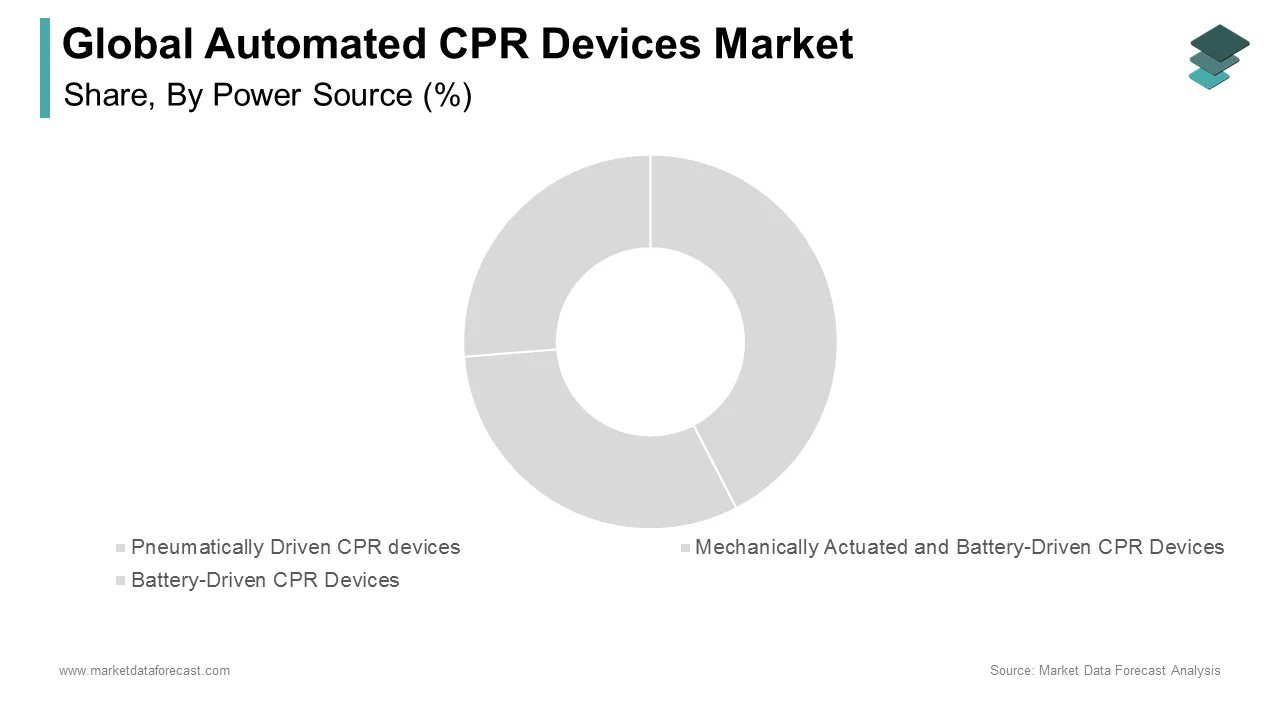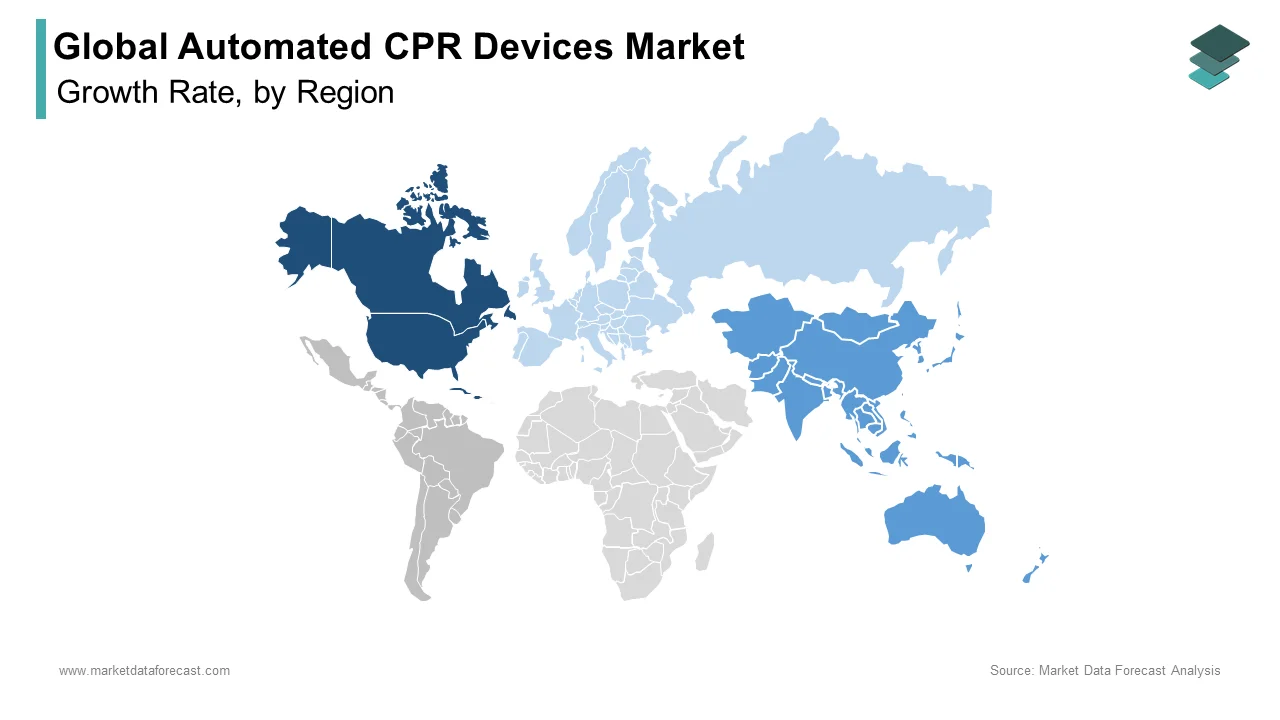Global Automated CPR Devices Market Size, Share, Trends & Growth Forecast Report By Power Source (Pneumatically Driven CPR Devices, Mechanically Actuated and Battery Driven CPR devices and Battery-Driven CPR Devices), Kind Of Device (Load Distribution Devices, 3D Compression Devices and Validation Biomarkers) and Region (North America, Europe, Asia-Pacific, Latin America, Middle East and Africa), Industry Analysis From 2025 To 2033.
Global Automated CPR Devices Market Size
The global automated CPR devices market was valued at USD 125 million in 2024. The global market is estimated to be growing at a CAGR of 12.4% from 2025 to 2033 and will be worth USD 358 million by 2033 from USD 140.5 million in 2025.

Cardiopulmonary resuscitation (CPR) is a crisis and lifesaving method comprised of chest pressure and artificial ventilation. CPR is performed to keep the bloodstream and oxygenation in mind if there should be an occurrence of heart failure. CPR's primary capacity is to keep up the partial flow of oxygenated blood to the mind and heart. The principal design is to defer tissue passing to adequate resuscitation and protect the cerebrum from perpetual harm. Automated CPR devices are signed to perform CPR with precise predictions mechanically and more efficiently than manual help. The drawbacks of manual CPR, such as irregular rhythm, too much pressure, fatigue for the healthcare professional, wrong technique, etc., were eradicated using automated CPR devices.
MARKET DRIVERS
The growing incidence and prevalence of CVDs is one of the primary factors driving the global automated CPR devices market growth.
According to the statistics published by the World Health Organization, every year, more than 17.9 million die from CVDs, which is approximately 31% of worldwide deaths. Furthermore, rising Interest in EMS (Emergency Medical Services), the surge in open awareness regarding heart failure and clinical advantages of CPR gadgets, expanding government subsidizing and awards, and the developing geriatric population are significant drivers of the market. Furthermore, the increasing incidence of cardiovascular disease and out-of-emergency clinic heart failure across the globe are expected to drive the automated CPR devices market.
Technological advancements are further supporting the automated CPR market growth.
Mechanical CPR systems, such as automated CPR techniques, have helped improve the quality and efficiency of CPRs. Mechanical CPR systems were created in response to the problems with manual CPR to increase the quality of CPR, a crucial factor in survival. Application studies have demonstrated that mechanical CPR devices can increase coronary and cerebral blood flow by increasing arterial carbon dioxide levels, a sign of greater tissue perfusion and better hemodynamic circumstances. However, these devices could anticipate better results if automated mechanical CPR is assumed to perform consistent chest compressions.
MARKET RESTRAINTS
However, the significant expense of automated CPR devices, their considerable weight, high preparation necessities, and clashing consequences of observational studies are minor restrictions in the worldwide automated CPR device market.
REPORT COVERAGE
|
REPORT METRIC |
DETAILS |
|
Market Size Available |
2024 to 2033 |
|
Base Year |
2024 |
|
Forecast Period |
2025 to 2033 |
|
Segments Covered |
By Power Source, Kind of Device, and Region |
|
Various Analyses Covered |
Global, Regional & Country Level Analysis, Segment-Level Analysis; DROC, PESTLE Analysis; Porter'sive Forces Analysis, Competitive Landscape, Analyst Overview of Investment Opportunities |
|
Regions Covered |
North America, Europe, APAC, Latin America, Middle East & Africa |
|
Market Leaders Profiled |
Zhuhai Kindway Medical Science & Technology Co., Ltd, ZOLL Medical Corporation, CPR Medical Devices, Inc., and Medtronic, Inc. |
SEGMENTAL ANALYSIS
Global Automated CPR Devices Market Analysis By Power Source

The pneumatically driven CPR devices segment leads with the dominant shares of the market. The segment is growing since it is the most used power source.
The battery-driven CPR devices segment is likely to have the highest CAGR in the foreseen years due to the increasing adoption of the latest technologies. Additionally, battery-driven Automated CPR devices are easier to use, and the batteries can be replaced every time, driving the demand for this market.
Global Automated CPR Devices Market Analysis By Kind of Device
The load distribution devices market holds the largest market share with the increasing number of hospitals and clinics. In addition, rising support from the government authorities is also propelling the market's growth. Furthermore, the segment is growing because it is the most commonly used automated device.
On the other hand, the 3D compression devices segment is expected to hold a significant share of the automated CPR devices market during the forecast period due to the growing popularity of the device due to its advanced features and enhanced efficiency.
REGIONAL ANALYSIS

North America is expected to have the largest global market share during the forecast period, followed by Europe. North America and Europe together constitute around 60% of the market share. The rising number of people suffering from cardiovascular problems is enhancing the market demand in North America. In addition, the hesitance of the health experts to do the CPR process and high capital prerequisites for the work of CPR devices in the vast EMS structure of the U.S is other factors fuelling the growth rate of the automated CPR devices market.
Asia-Pacific is expected to grow considerably due to increasing awareness and Technological Advancements. Technological advancements combined with increasing awareness of heart failure management in regions such as the Asia Pacific and Latin America are estimated to boost interest in automated CPR devices. Moreover, it is expected to represent various opportunities for global and regional specialty players to enter the markets in these regions with cost-effective offerings to acquire a considerable market share.
In 2024, Europe accounted for a substantial share of the global market. The European market must stay prevailing in the worldwide automated CPR device market throughout the period. This is because of exceptionally progressed EMS, high reception rates of CPR advances, and increased buyer comprehension of clinical advantages in control to the expanding need for automated CPR devices in the concerned area.
Latin America and MEA are relied upon to display a nearly moderate CAGR during the forecast period.
KEY PLAYERS IN THE AUTOMATED CPR DEVICES MARKET
Some notable companies dominating the global automated CPR devices market are Zhuhai Kindway Medical Science & Technology Co., Ltd, ZOLL Medical Corporation, CPR Medical Devices, Inc., and Medtronic, Inc.
RECENT HAPPENINGS IN THIS MARKET
- In October 2022, the LUCAS device, which runs on batteries, is intended to improve the standard of automated CPR. The LUCAS gadget eliminates tiredness, individual differences, or psychological variables from CPR and eliminates the requirement to replace CPR providers every two minutes. In addition, in circumstances like patient mobility and transportation, extended CPR, or the cath lab, LUCAS provides high-quality and safer chest compressions.
- In February 2022, CPR Therapeutics Inc. recently announced receiving a U.S. patent for another technological element underlying its multimodal cardiopulmonary resuscitation (CPR) system, such as the INCORPORATION OF THE ELECTRODES FOR DEFIBRILLATION INTO THE PATIENT-FACING CO.
- In May 2022, the modified physiological approach to CPR through CPR employing HTup postures and adjuncts to reduce ICP was used in pilot clinical investigations of OHCA. According to a new study published in Critical Care Medicine, CPR in the head-up/torso-up (HTup) position is linked to noticeably higher chances of neurologically favorable out-of-hospital cardiac arrest (OHCA) survival.
- In March 2022, in its most recent Series A funding round, Avive raised $22 million to advance the development of its intelligent automated external defibrillator technology and platform, which functions like Doordash for the delivery of AEDs and assistance during cardiac arrest; the company is already testing the program in a few cities. The AED from Avive is combined with a data-driven software platform for emergency response. While waiting for emergency medical services (EMS) to arrive, the objective is to provide AED assistance to someone experiencing sudden cardiac arrest.
DETAILED SEGMENTATION OF THE AUTOMATED CPR DEVICES MARKET INCLUDED IN THIS REPORT
This market research report on the global automated CPR devices market has been segmented and sub-segmented based on the power source, kind of device, and region.
By Power Source
- Pneumatically Driven CPR devices
- Mechanically Actuated and Battery-Driven CPR Devices
- Battery-Driven CPR Devices
By Kind of Device
- Load Distribution Devices
- 3D Compression Devices
- Validation Biomarkers
By Region
- North America
- Europe
- Asia Pacific
- Latin America
- Middle East & Africa
Frequently Asked Questions
What was the size of the automated CPR devices market worldwide in 2023?
The global automated CPR devices market size was valued at USD 125 million in 2024.
Does this report include COVID-19 on this market?
In this report, a detailed analysis of how has COVID-19 impacted the automated CPR devices market is included.
Which region led the automated CPR devices market in 2023?
North America dominated the market in 2024.
Which are a few of the notable players in the automated CPR devices market?
Zhuhai Kindway Medical Science & Technology Co., Ltd, ZOLL Medical Corporation, CPR Medical Devices, Inc., and Medtronic, Inc. are some of the promising players in the automated CPR devices market.
Related Reports
Access the study in MULTIPLE FORMATS
Purchase options starting from
$ 2500
Didn’t find what you’re looking for?
TALK TO OUR ANALYST TEAM
Need something within your budget?
NO WORRIES! WE GOT YOU COVERED!
Call us on: +1 888 702 9696 (U.S Toll Free)
Write to us: sales@marketdataforecast.com
